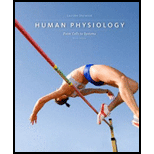
To explain:
Saltatory conduction propagates action potential more rapidly than contiguous conduction.
Introduction:
An action potential is a short, quick, large (100 mV) membrane potential change, during which the potential is reversed to make the inner cell more positive than the exterior. The axon hillock is the trigger area for the neuron because it is the site where the action potential is activated or initiated by a sufficiently large graded potential. When the axon hillock initiates an action potential, the rest of the nerve fiber is not activated by any more triggering effect. The impulse is carried out automatically throughout the neuron by one of two modes of transmission: adjacent conduction and saltatory conduction, without further stimulus.
Want to see the full answer?
Check out a sample textbook solution
Chapter 4 Solutions
Human Physiology: From Cells to Systems (MindTap Course List)
- Define an action potential.arrow_forwardDraw and label an action potential, indicating the ion movements responsible for the rising phase and the falling phase.arrow_forwardConformational changes in channel proteins brought about by voltage changes are responsible for opening and closing Na+ and K+ gates during the generation of an action potential. (True or false?)arrow_forward
- Describe the characteristics of action potentials and explain how they are conducted by unmyelinated and myelinated axons.arrow_forwardState whether the channels listed would be open or closed at the corresponding numbered phases of the action potential graph. Phase on Graph Sodium Voltage Gated channels Potassium Voltage Gated channels 1 2 3 4arrow_forwardDescribe how action potentials are conducted by unmyelinated nerve fibers. Why is saltatory conduction in myelinated fibers more rapid?arrow_forward
 Human Physiology: From Cells to Systems (MindTap ...BiologyISBN:9781285866932Author:Lauralee SherwoodPublisher:Cengage Learning
Human Physiology: From Cells to Systems (MindTap ...BiologyISBN:9781285866932Author:Lauralee SherwoodPublisher:Cengage Learning Human Biology (MindTap Course List)BiologyISBN:9781305112100Author:Cecie Starr, Beverly McMillanPublisher:Cengage Learning
Human Biology (MindTap Course List)BiologyISBN:9781305112100Author:Cecie Starr, Beverly McMillanPublisher:Cengage Learning

